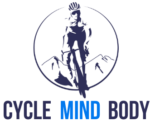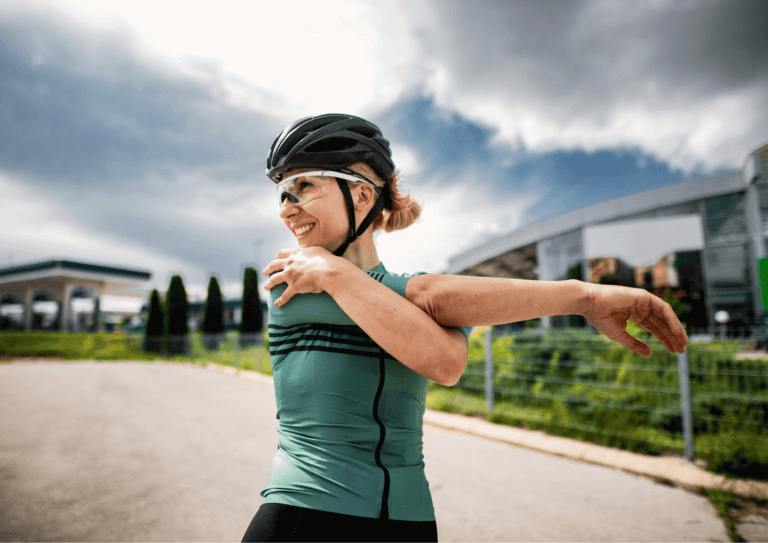Cycling isn’t just about pedaling – it’s a full-body endeavor that demands flexibility, strength, and comfort. As cyclists, we’ve all experienced discomfort on the bike due to tight or sore muscles, and it’s anything but enjoyable.
In this comprehensive guide, we’ll delve into the world of cyclist-focused stretches, exploring how these simple moves can elevate your cycling experience.
Whether you’re a casual rider or a dedicated cyclist, integrating these stretches into your routine can improve your performance, prevent injuries, and enhance your overall health.
Let’s dive into the best stretches that will unlock your potential on the road and bring you a more enjoyable and fulfilling cycling journey.
Why Cyclists Need to Stretch
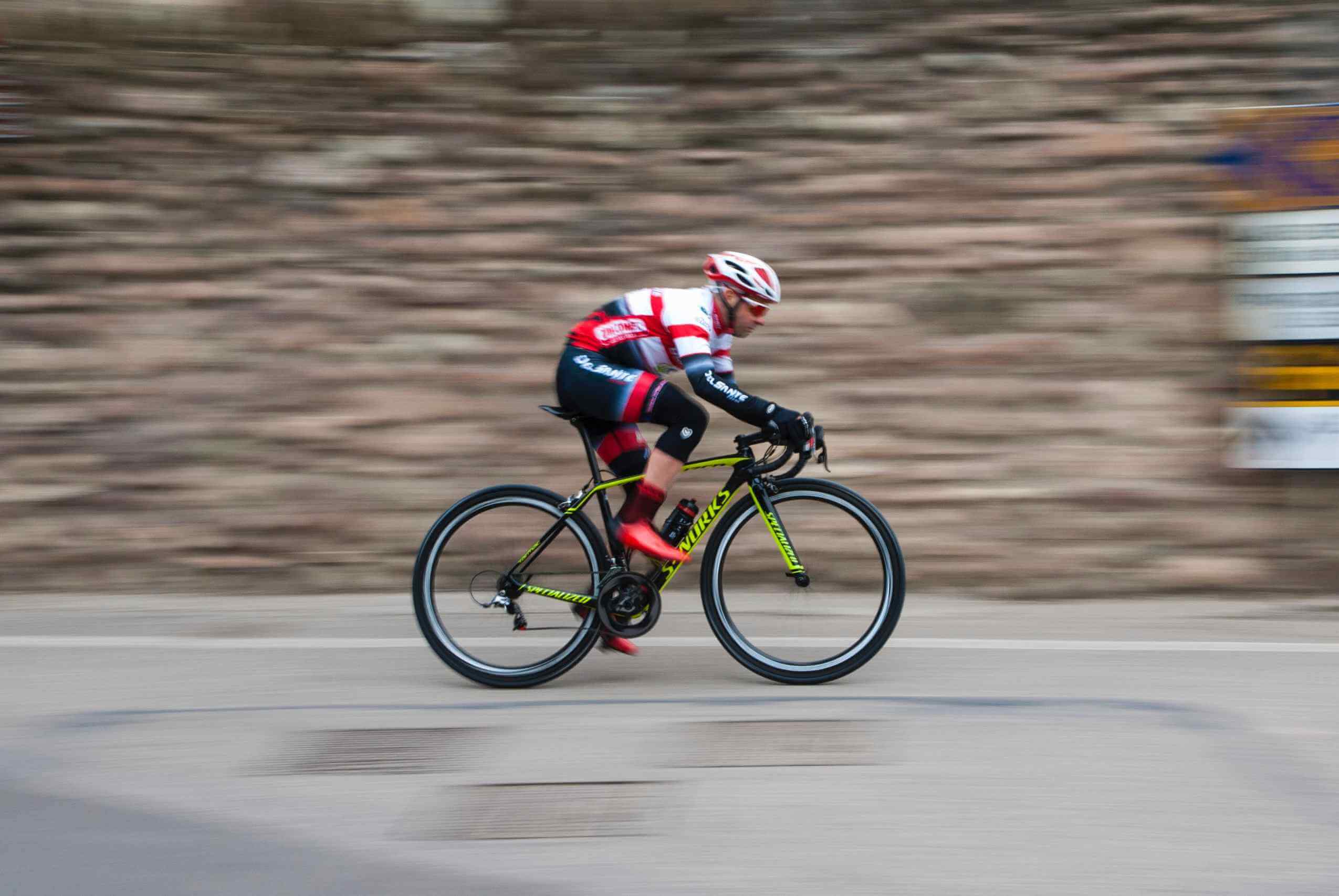
Cycling involves a continuous and repetitive movement pattern that can gradually lead to muscle tightness and imbalances. The repetitive motion can cause certain muscles in your body to become tight and imbalanced.
This is particularly true for muscles like the quadriceps, hip flexors, and lower back, which play a central role in pedaling and maintaining a stable riding position.
Regular stretching is essential for cyclists because it targets these specific muscle groups. When you stretch, you’re actively working to release built-up tension in these areas.
By doing so, you help your body return to a more balanced state, which not only feels better but also contributes to improved performance on the bike.
Imagine your muscles as rubber bands. After a lot of use (or cycling in this case), they can become tense and less flexible. Stretching is like gently stretching out these rubber bands, allowing them to regain their elasticity and function.
When your muscles are more relaxed and flexible, you’ll find it easier to maintain a proper cycling posture, generate power with each pedal stroke, and reduce the risk of injuries caused by overused muscles.
So, while cycling is undoubtedly an enjoyable activity, it’s crucial to remember that a bit of stretching can go a long way in making your rides smoother, more comfortable, and more rewarding.
1. Quadriceps Stretch: Unleash the Power in Your Thighs
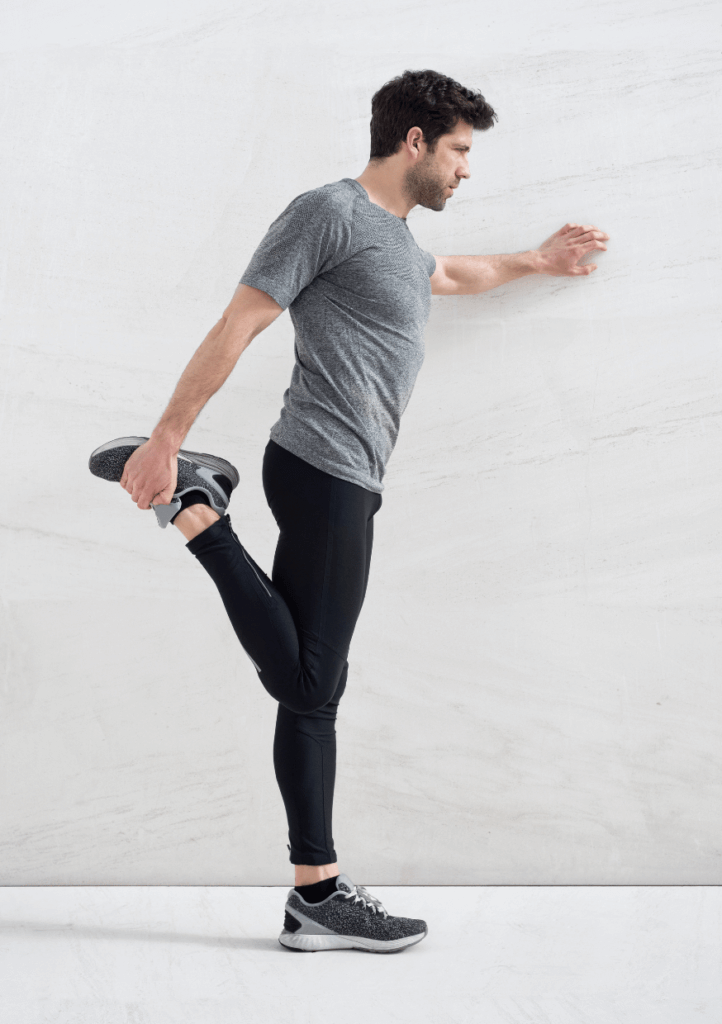
Your quadriceps, the muscles on the front of your thighs, play a pivotal role in driving each pedal stroke during cycling. These muscles are the powerhouse that propels your bike forward, making them a critical focus for any cyclist.
Keeping your quadriceps flexible is not only essential for optimal cycling performance but also for preventing discomfort and potential injuries.
To perform the quadriceps stretch:
1. Stand on one leg and bend the opposite knee, bringing your heel towards your glutes.
2. Hold your ankle with your hand and gently pull it closer to your glutes.
3. As you do this, you’ll feel a gentle stretch along the front of your thigh.
Regularly incorporating quadriceps stretches into your routine offers multiple benefits. These stretches enhance the health of your knees by maintaining proper muscle balance around the joint.
This helps to reduce the risk of injuries that can occur from imbalances. Moreover, by preventing muscle fatigue and stiffness, quadriceps stretches contribute to improved pedal power.
2. Hip Flexor Stretch: Loosen Up for Better Performance
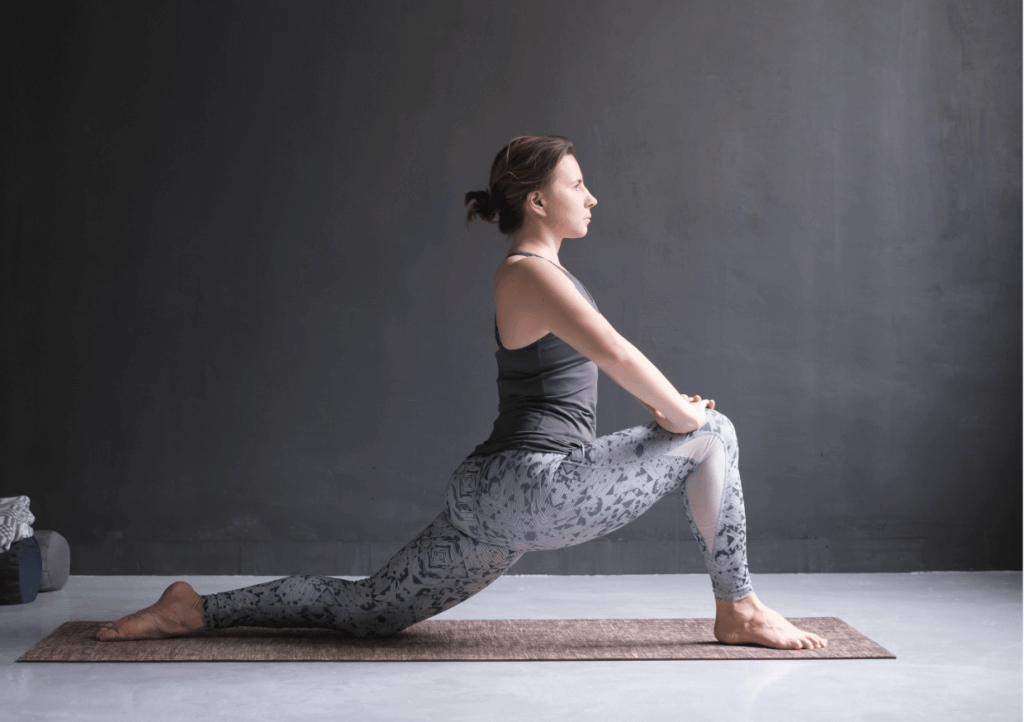
Tight hip flexor muscles can have a significant impact on your cycling experience, affecting both your posture and your pedal stroke.
These muscles, located in the front of your hips, can become shortened and tight due to the repetitive motion of cycling. This tightness can lead to discomfort and hinder your cycling efficiency.
Counteracting this discomfort is achievable through the hip flexor stretch:
1. Start in a lunge position with one foot positioned forward.
2. Gently push your hips forward while keeping your upper body upright.
3. As you lean into the stretch, you’ll notice a sensation of stretching in the front of your hip.
By incorporating the hip flexor stretch into your regular routine, you’re not only promoting flexibility in your hip flexor muscles but also enhancing your pedal efficiency.
This means that your pedal strokes become more fluid, allowing you to maintain a consistent rhythm and exert less effort while cycling.
Additionally, this stretch contributes to reducing lower back discomfort that may arise due to tight hip flexors. This, in turn, supports a more comfortable and enjoyable ride overall.
3. Lower Back Stretch: Relieve Tension and Ride Stronger
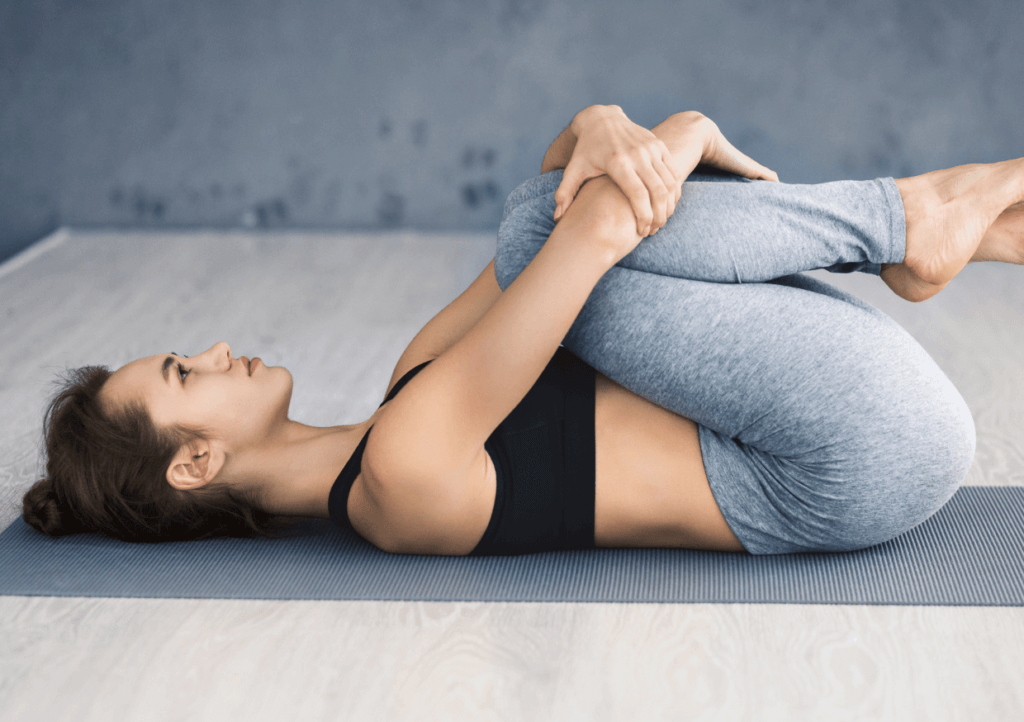
Tightness in your lower back can negatively impact your posture and power output while cycling. The lower back muscles play a crucial role in supporting your spine and maintaining your posture on the bike.
When these muscles become tight, they can lead to discomfort, limited range of motion, and even back pain.
Counterbalancing this discomfort is as simple as incorporating the lower back stretch into your routine:
1. Lie on your back and draw your knees towards your chest.
2. Gently rock side to side, allowing your lower back to experience a soothing massage.
3. While holding the stretch, you’ll gradually feel the tension releasing.
Incorporating this stretch into your routine has several benefits for cyclists. Firstly, it promotes relaxation and releases tension in the muscles of your lower back.
This relaxation can help to alleviate discomfort caused by tight muscles and promote a greater sense of well-being after a ride.
Additionally, the lower back stretch enhances your stability on the bike. When your lower back muscles are flexible and relaxed, you’re better able to maintain an optimal riding position, reducing the strain on your back and promoting a more powerful and efficient pedal stroke.
4. Neck Stretch: Maintain Comfort and Awareness on the Road

Even though cycling primarily engages the lower body, your neck deserves attention too, especially during extended rides.
The neck is responsible for supporting your head and maintaining proper alignment, and any tension or discomfort in this area can significantly impact your riding experience.
The neck stretch can help address this area:
1. Sit or stand up straight.
2. Gently tilt your head to one side, bringing your ear closer to your shoulder.
3. For a deeper stretch, use your hand to gently apply pressure on the opposite side of your head.
Maintaining neck flexibility through this stretch is essential for several reasons. Firstly, it enhances visibility by ensuring that you can turn your head comfortably to check for traffic or obstacles.
Additionally, the neck stretch reduces strain. By releasing tension in the neck muscles, you can prevent discomfort and potential headaches that may arise from prolonged riding.
Ultimately, the neck stretch enhances your overall riding experience by allowing you to stay comfortable, aware, and focused on the road ahead.
5. Glute Stretch: Enhance Strength and Resilience
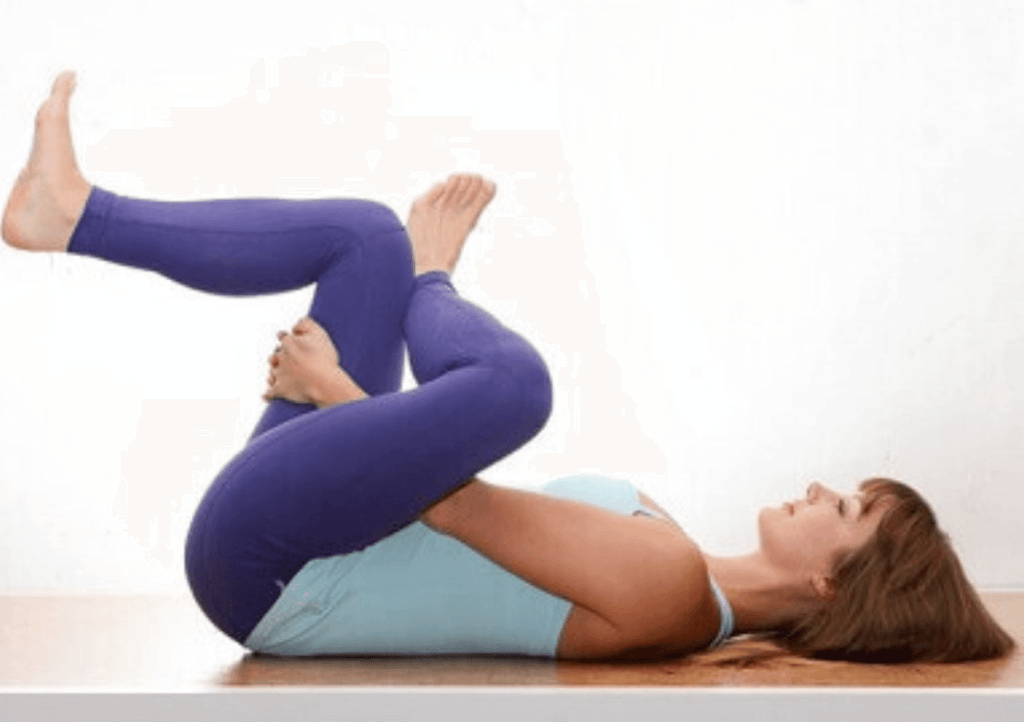
Your glutes, the muscles in your butt, are essential for generating power and stabilizing your pelvis while cycling. These muscles play a critical role in propelling your bike forward and maintaining your balance on the saddle.
Ensuring that your glutes remain flexible and strong is vital for preventing discomfort and optimizing your cycling performance.
This stretch is also good for stretching your piriformis muscle. This is located near the sciatic nerve can lead to discomfort for cyclists. The sciatic nerve runs from your lower back through your hips and down each leg, and when the piriformis muscle becomes tight or inflamed, it can put pressure on the nerve, leading to pain known as sciatica.
Stretching these muscles effectively is simple:
1. Lie on your back and cross one ankle over the opposite knee.
2. Gently pull the uncrossed leg towards your chest.
3. As you do this, you’ll feel a stretching sensation in your glutes.
Incorporating glute stretches into your routine offers several advantages for cyclists. Firstly, it promotes injury prevention. Flexible glutes can help prevent strain on the lower back and surrounding muscles, reducing the risk of discomfort and potential injuries.
Secondly, glute stretches enhance pedal efficiency. When your glutes are both flexible and strong, you’re better able to engage them effectively during your pedal strokes, allowing you to generate more power and maintain a smooth and consistent rhythm.
Additionally, glute stretches contribute to overall cycling strength. By maintaining the flexibility and strength of these muscles, you’re setting the stage for improved cycling resilience and performance.
6. Calf Stretch: Boost Your Pedal Power and Prevent Strain
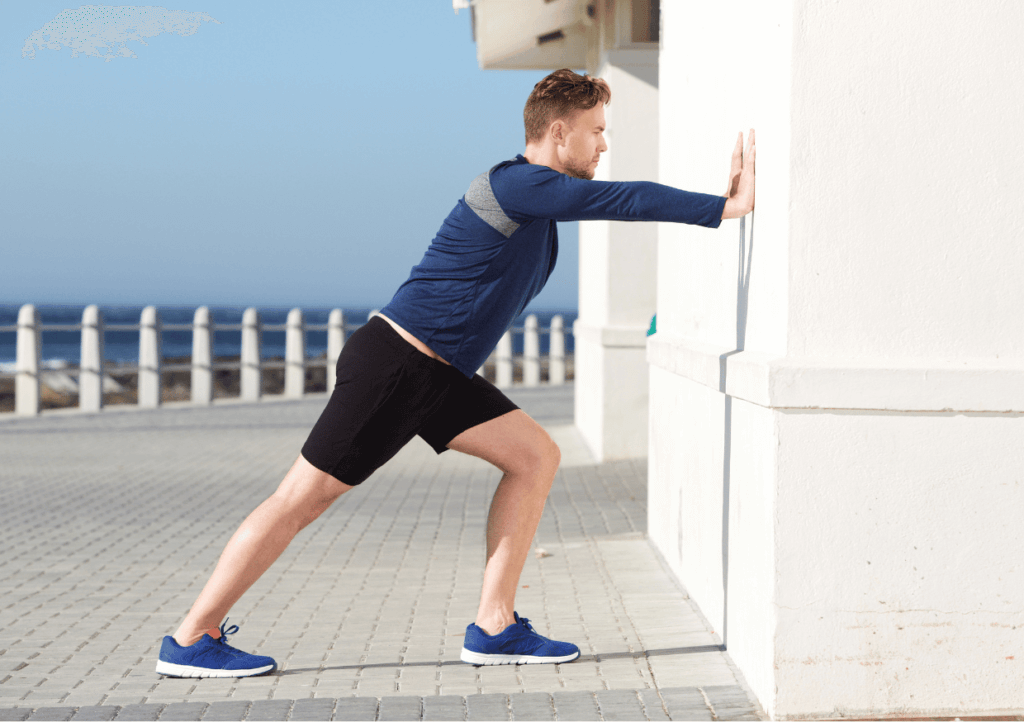
Powerful calves are crucial for generating pedal power, as they are responsible for the push and pull motion that propels your bike forward. However, the repetitive motion of cycling can lead to calf muscles becoming tight and potentially prone to cramps and discomfort.
The calf stretch is an effective way to address this issue:
1. Stand facing a wall, with one leg extended behind you.
2. Keep your heel on the ground and lean gently into the wall until you feel a stretching sensation in your calf.
3. Hold the position for several seconds on each leg.
Regular calf stretches offer several advantages for cyclists. Firstly, they prevent cramps. When your calf muscles are flexible and well-stretched, you’re less likely to experience the painful cramps that can disrupt your ride.
Secondly, calf stretches improve pedal mechanics. Flexible calf muscles allow you to fully engage the entire range of motion in your pedal stroke, contributing to a more efficient and powerful ride.
Lastly, calf stretches ensure that you remain comfortable while cycling. Tight calf muscles can lead to discomfort and even pain, which can hinder your overall cycling experience.
By keeping your calves flexible and relaxed through regular stretching, you’re promoting a more enjoyable and comfortable ride.
7. Child’s Pose Stretch: Total Body Relaxation for Cyclists
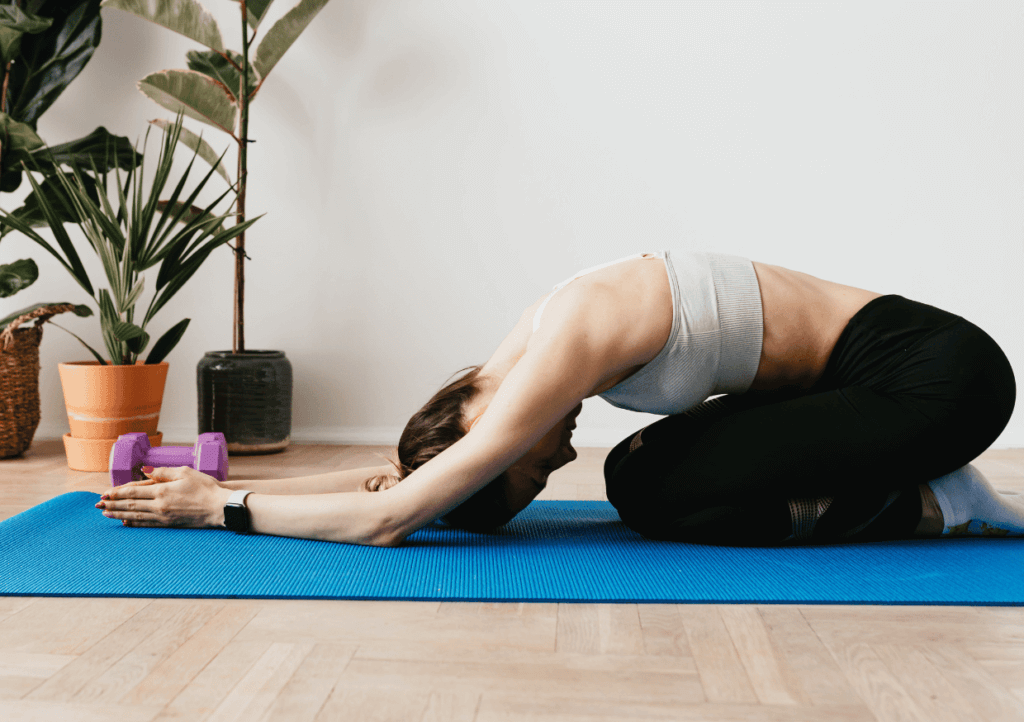
After intense rides, your body craves relaxation.
The child’s pose stretch offers a soothing and effective way to achieve this relaxation:
1. Begin by kneeling on the ground, ensuring your big toes touch and your knees are spread wide.
2. Sit back on your heels and reach your arms forward, elongating your spine.
3. As you settle into the stretch, you’ll feel a gentle release along your spine and in your hip area.
Incorporating the child’s pose stretch into your routine has multiple benefits for cyclists. Firstly, it aids in recovery. After challenging rides, your muscles may feel tight and fatigued.
The child’s pose stretch allows you to gently stretch these muscles, promoting blood flow and aiding in their recovery process. Secondly, the child’s pose stretch maintains flexibility.
The stretch targets multiple muscle groups, including your back, hips, and thighs, ensuring that these areas remain flexible and supple. Lastly, the child’s pose stretch supports overall relaxation.
Cycling can be physically demanding, and this stretch offers a moment of tranquility and relaxation. By embracing the child’s pose stretch, you’re ensuring that your body remains flexible, balanced, and primed for optimal cycling performance.
Incorporating this stretch into your routine can lead to a more comfortable, enjoyable, and fulfilling cycling experience.
FAQ About Stretching for cyclists
How often should I perform these stretches?
Consistency is key when it comes to reaping the benefits of these stretches. Aim to include a 10-15 minute stretching routine after each ride. This post-ride stretching session helps to release tension that has built up during your cycling session.
Additionally, incorporating a longer stretching session into your weekly routine, perhaps after a particularly intense ride or during your rest days, can help maintain flexibility and prevent muscle tightness over the long term. Remember, the more you integrate these stretches, the more your body will thank you for it.
What is the best time to perform these stretches?
For post-ride stretches, it’s ideal to do them after you’ve completed your cycling session. Your muscles are warm, and stretching at this time helps prevent them from becoming tight and stiff.
However, you can also integrate some of these stretches into your pre-ride warm-up. Just make sure to focus on dynamic stretches that gently activate your muscles without overstretching them.
Should I hold each stretch for a specific amount of time?
Yes, holding each stretch for about 20-30 seconds is generally effective for improving flexibility. This duration allows your muscles to relax and lengthen.
However, it’s essential to listen to your body. If a stretch feels uncomfortable or painful, back off a little. Never force a stretch beyond what feels comfortable.
Can these stretches help with reducing muscle soreness?
Yes, these stretches can contribute to reducing muscle soreness after a ride. Post-ride stretching helps promote blood flow to your muscles, which aids in flushing out metabolic waste products that can contribute to soreness.
By maintaining flexibility and addressing any muscle tightness, you’re supporting your body’s recovery process and potentially minimizing the intensity of muscle soreness the next day.
Can stretching really improve my cycling performance?
Absolutely! Stretching plays a crucial role in enhancing your cycling performance. Flexible muscles allow for a more efficient pedal stroke, as they enable you to move through the full range of motion with ease. This improved pedal efficiency translates to better power output, helping you generate more force with each pedal stroke.
Additionally, stretching contributes to better posture on the bike. When your muscles are flexible and balanced, you’re more likely to maintain a comfortable and effective riding position. Altogether, proper stretching leads to an improved overall cycling experience, helping you ride stronger and more comfortably.
